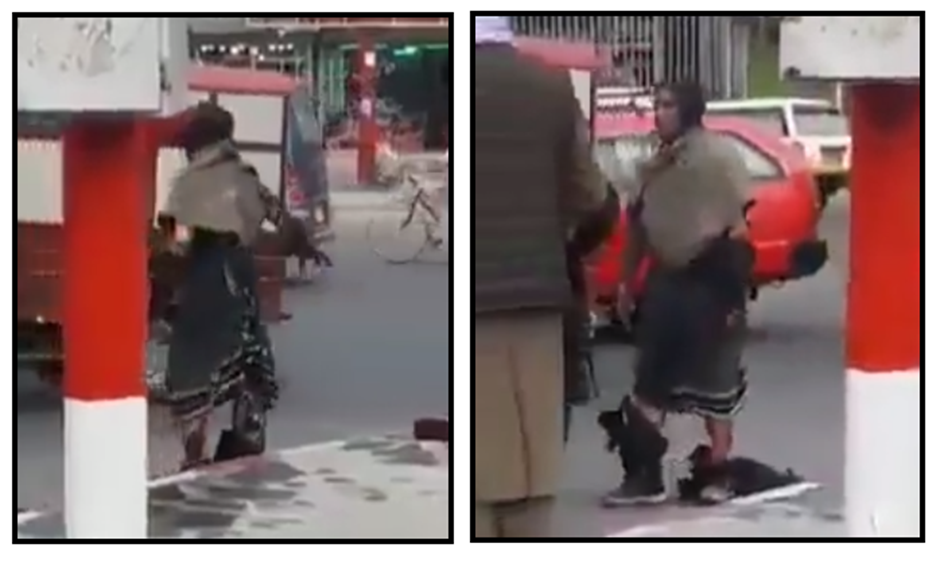Warning: this article describes reports of suicide and contains links to graphic material.
On the morning of April 18, a man doused himself in oil and set himself alight in the Dehmazang Square in Kabul. A Twitter post from the online publication Afghanistan International reported that the reason for this was “unemployment and economic problems”. Khavari Media, a Facebook page followed by over 90k people, reported that the man claimed that he could not afford food for his family and they all slept hungry.
In a video shared online of the incident, the man can be seen with his clothes on fire, and, according to international Shia news agency, Shafaqna.com, was accompanied by his four-year-old son at the time.
 Figure 1: Geolocation of the incident recorded at the Dehmazang Square in Kabul.
Figure 1: Geolocation of the incident recorded at the Dehmazang Square in Kabul.
The footage, shared on Twitter, shows the man on fire walking from the centre of the roundabout in Dehmazang Square and leaving the child behind. As he walked into traffic, several men, including the Taliban, attempted to extinguish the fire using pieces of cloth. After the fire is put out, the crowd directs the man back to the centre of the roundabout where the young boy is waiting. At the end of the video, the man turns to onlookers and loudly chants Islamic verses, saying that “Mohammad is the messenger” and “there is no god but Allah.”
 Figure 2: Image shows the man after the fire has been distinguished, sat down at the roundabout with the young child behind him
Figure 2: Image shows the man after the fire has been distinguished, sat down at the roundabout with the young child behind him
In other footage, shared by a Twitter user, the burnt man can be seen walking around in destroyed clothes, with signs of an injury on his left leg, likely caused by burns.
 Figure 3: Screenshots of the video showing the man with burnt clothes at Dehmazang Square, Kabul.
Figure 3: Screenshots of the video showing the man with burnt clothes at Dehmazang Square, Kabul.
On April 19, the Kabul News Twitter account, which has over 267k followers, published an update claiming that the man died due to his injuries after being taken to the Istiqlal Hospital in Kabul the previous day.
Perhaps conscious of the role self-immolations have played in public uprisings and protests elsewhere in the world – most notably in Tunisia, where one case of self-immolation triggered what would become known as the Arab Spring – the Taliban appeared keen to head-off suggestions that the self-immolation was driven by poverty and hardship.
Two videos surfaced online of interviews with alleged family members. One of the videos shows an unidentified member of the Taliban interviewing an old man who claims to be the father of the man who had self-immolated. The Taliban member starts by saying that the man who set himself on fire was called ‘Speengul’ and that the media had spread rumours that he acted out of poverty and hunger and blamed the Taliban. He goes on to say that none of the former is true and to prove it, he asks the man’s father to ‘tell the truth’. The old man then says that his son was neither hungry nor thirsty, however, was suffering from mental health problems.
 Figure 4: Screenshot of the video of a Taliban member (left) interviewing the alleged father (right) of the burned man.
Figure 4: Screenshot of the video of a Taliban member (left) interviewing the alleged father (right) of the burned man.
The second video features a man who claims to be Speengul’s brother. He is seen talking directly into the camera as someone asks him questions. He is heard saying that he is a shopkeeper and his father a farmer and that, for the past year and a half, his brother was unemployed but was not struggling financially. He added that his brother had a wife and two children and was struggling emotionally.
The self-immolation incident comes at a time when reports of suicides attributed to a range of reasons appear to be increasingly common in Afghanistan. In the last week, on April 13, the Salam Watandar Farsi Facebook page, followed by over 68k people, published a story about a suicide in the province of Faryab. A young man called Nooruddin ended his life by ingesting mouse poison. According to the story, one of his relatives claimed he had mental health problems, however, another family member attributed his suicide to “love and romance”.
On April 15, an 18-year-old girl took her own life in Taleqan City, Takhar Province. An article from Etilaatroz claimed that the girl died of suicide by hanging. According to the newspaper, unnamed sources told the reporter that the girl’s mother wanted to take her body to a provincial hospital for further examination, however, the Taliban did not allow her to. Consequently, the actual cause and motive for the girl’s death could not be verified.
On April 19, a young woman was found dead in Daikundi. Local sources told Etilaatroz newspaper that she had died of suicide, although the motive was unclear. Ghulam Ali Javed, the Spokesman for the Taliban Police in Daikundi Province, told the newspaper that the woman hung herself on Monday, adding that there is an investigation underway to try to discover the motive. According to the article, the press officer of the Taliban police command in Daikundi, who was left unnamed, stated that a medical team had examined the deceased body and found no traces of violence.
While the circumstances surrounding these deaths remain unclear, Afghanistan has endured a deepening economic crisis since the US withdrawal and Taliban takeover last August. According to Relief Web, 95 percent of households have been experiencing insufficient food consumption and food insecurity, while the United Nations Development Programme (UNDP) says 97 percent of Afghans could plunge into poverty by mid-2022.


